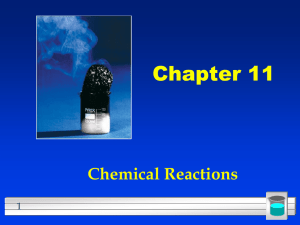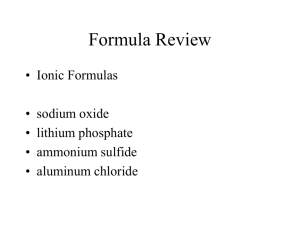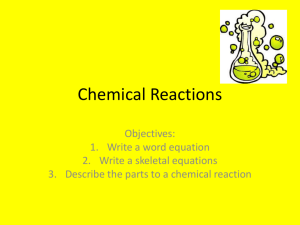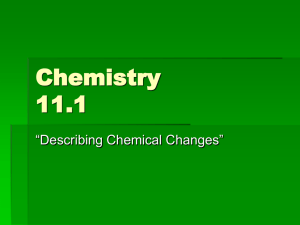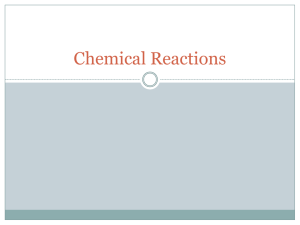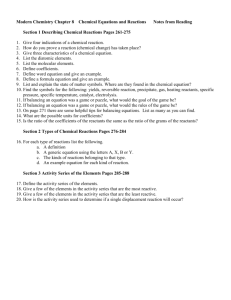Describing Chemical Reactions
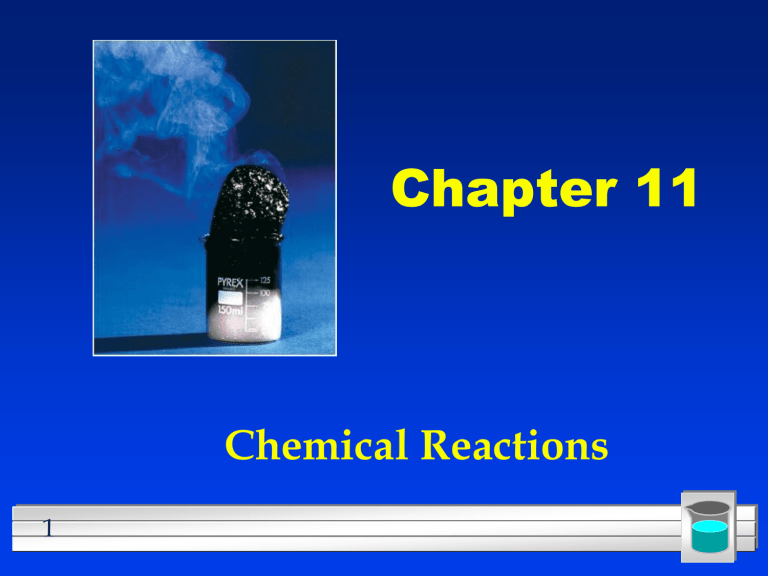
1
Chapter 11
Chemical Reactions
2
Section 11.1
Describing Chemical Reactions
Objective 1: You will learn to identify when a chemical reaction takes place.
Objective 2: You will know what the “Law of
Conservation of Mass” means.
Objective 3: You will be able to write both word and formula equations.
Objective 4: You will know what all the different symbols used in writing chemical equations mean.
How Do You Know A Rxn Has
Occurred???
• Heat and/or light is produced light and heat rxn
• Production of gas
• Formation of a precipitate
• Color change precipitate and color change
3
Law of Conservation of Mass
Atoms are neither created or destroyed
Antoine Lavoisier (1743-1794)
4
Communicating a chemical reaction
In a sentence every item is a word
…
Copper reacts with chlorine to form copper
(II) chloride.
In a word equation some symbols used … copper + chlorine
copper (II) chloride
In a formula all symbols used …
Cu(s) + Cl
2
(g)
CuCl
2
(s)
5
All chemical reactions… have two parts:
1. Reactants = the substances you start with
2. Products = the substances you end up with
The reactants will turn into the products.
Reactants
Products
6
Symbols in equations? –
Text page 323
the arrow separates the reactants from the products
(arrow points to products)
–Read as: “reacts to form” or yields
The plus sign means “and”
(s) after the formula = solid: Fe
(s)
(g) after the formula = gas: CO
2(g)
(l) after the formula = liquid: H
2
O
(l)
7
Symbols used in equations
(aq) after the formula = dissolved in water, an aqueous solution:
NaCl
(aq) is a salt water solution
used after a product indicates a
gas has been produced : H
2
used after a product indicates a solid has been produced : PbI
2
8
Symbols used in equations
■ double arrow indicates a reversible reaction (more later)
■
,
shows that heat is supplied to the reaction
■ is used to indicate a catalyst is supplied (in this case, platinum is the catalyst)
9
What is a catalyst?
A substance that speeds up a reaction, without being changed or used up by the reaction.
Enzymes are biological or protein catalysts in your body.
10
1.
Write a skeleton equation for:
Solid iron (III) sulfide reacts with gaseous hydrogen chloride to form iron (III) chloride and hydrogen sulfide gas.
2.
Nitric acid dissolved in water reacts with solid sodium carbonate to form liquid water and carbon dioxide gas and sodium nitrate dissolved in water.
11
Now, read these equations:
Fe
(s)
+ O
2(g)
Fe
2
O
3(s)
Cu
(s)
+ AgNO
3(aq)
Ag
(s)
+ Cu(NO
3
)
2(aq)
NO
2(g)
N
2(g)
+ O
2(g)
12
Homework 11.1 and 11.2
Due Friday, Dec. 2
Page 347
36, 39, 40, 42, 43, 44, 45a, 46, 47a,
48a, 49a, 50, 51a, 52 a-e
* Lab questions % composition due Friday as well*
13
